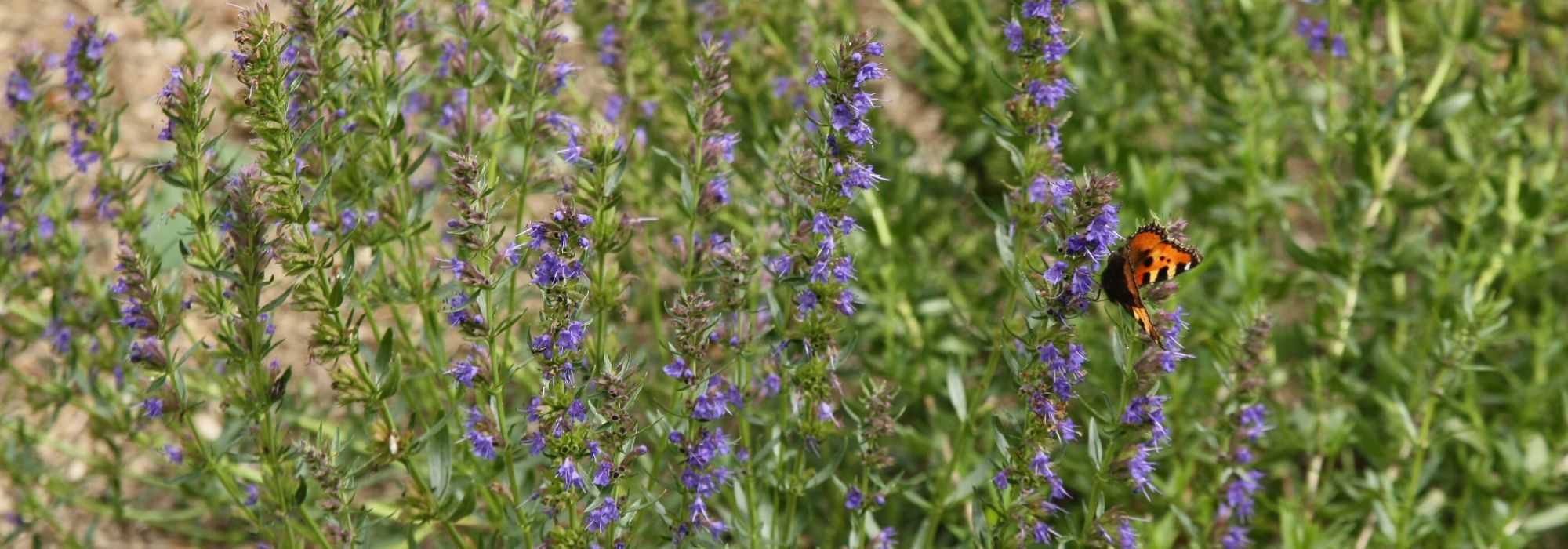
Hyssop, Hyssopus officinalis: sowing, planting, cultivation, benefits
Contents
Hyssop in a nutshell
- Hyssop or sacred herb is a lovely culinary and medicinal plant
- Its leaves, with a taste of thyme and rosemary, are essential in cooking and possess numerous virtues
- This hardy perennial undershrub showcases an abundant summer flowering in spikes, blue, white, or pink
- Undemanding and hardy, it is planted in full sun in very well-drained soil, even dry and poor
- Essential in the herb bed, it also has its place in rockeries and Mediterranean borders
A word from our expert
Hyssop or Hyssopus officinalis is a perennial herb highly valued in cooking for its aromatic foliage with a taste reminiscent of thyme and rosemary, perfect for flavouring numerous recipes! It is also used in the production of various spirits and liqueurs such as beer, Grande Chartreuse, Bénédictine, and Pastis… The sacred herb is renowned for its many virtues, particularly in treating digestive and breathing ailments. In some African beliefs, Hyssop is used for purification.
Throughout the summer, it blooms in long spikes, most often blue-purple, reminiscent of lavender.
Easy to cultivate, it thrives in sunny locations and prefers dry, well-drained, poor, and somewhat calcareous soils.
This Mediterranean undershrub will find its place in aromatic plant gardens, in pots on a balcony or terrace, as well as in borders and rockeries.
Use it for its ornamental and fragrant qualities in the garden or for its culinary properties in the vegetable patch!
Description and Botany
Botanical data
- Latin name Hyssopus officinalis
- Family Lamiaceae
- Common name Hyssop, Sacred herb
- Flowering Summer
- Height 0.45 to 0.60 m
- Exposure Sun, partial shade
- Soil type dry, poor and well-drained
- Hardiness below -15°C
Hyssop or “Sacred herb” is an aromatic undershrub, semi-woody, belonging to the Lamiaceae family, like thyme, rosemary, and lavender. It grows spontaneously in Mediterranean regions, particularly in Haute Provence, where it can be found on arid hills up to 2,000 m in altitude.
While the genus Hyssopus includes more than 8 species of aromatic shrubs or perennials, the only one cultivated in our gardens is Hyssopus officinalis with blue-violet flowering. It has given rise to 3 cultivars that differ from the type species by the colour of their flowers (white or pink) or their growth habit. Hyssopus officinalis var. Montana, or creeping hyssop, is a hybrid used in phytotherapy. Hyssop is sometimes confused with agastache, another Lamiaceae that is closely related and nicknamed “anise hyssop.”
From woody, ramified, and hard roots, the plant rises in small bushy tufts, regularly rounded, slightly spreading, and fragrant, reaching heights of 40 to 60 cm and widths of up to 1 m.
The numerous square and woody stems, characteristic of the Lamiaceae, bear very aromatic and semi-evergreen edible foliage.
Small glabrous leaves, linear, ovate to lanceolate, opposite, alternate along the upright branches. They measure 3 to 5 cm long, are entire, and have a single midrib. Green, slightly shiny, and very aromatic, they emit a fragrance reminiscent of savory, camphor, and rosemary, with a taste similar to mint. Its leaves, fresh or dried, are used to flavour many dishes.
On this dense bush, from July to September, pretty tubular flowers appear, clustered in narrow spikes at the ends of the stems. They are bilabiate and house a bouquet of prominent stamens. Generally blue-violet, they can also be white or pink depending on the cultivars.
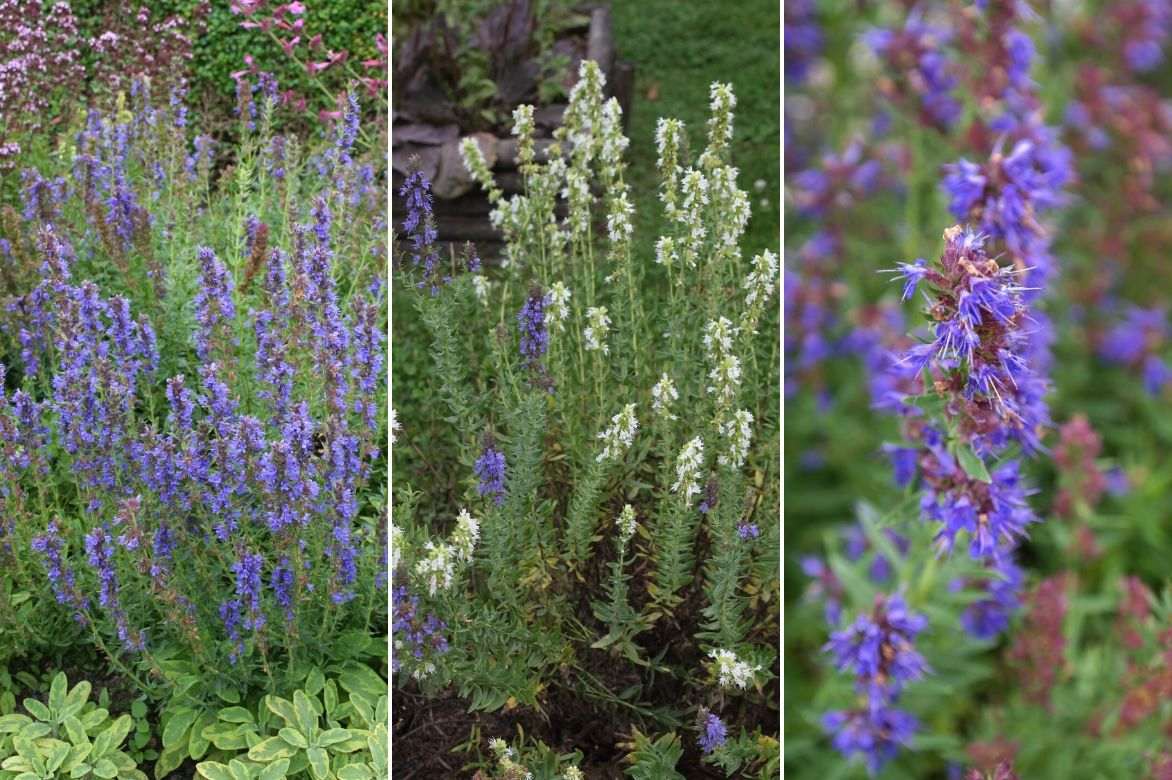
The Hyssopus officinalis with its lovely blue-violet melliferous flowers also exists in white and even pink.
This very beautiful flowering, reminiscent of lavender, is particularly melliferous and attracts bees and butterflies.
As a Mediterranean plant, Hyssop withstands cold very well, down to at least -15°C. This dwarf undershrub can settle anywhere. It develops easily in rather arid, poor, stony, well-drained, and calcareous soils, provided the exposure is very sunny; it will, however, tolerate partial shade in our warmest regions.
It will find its place in aromatic plant gardens. In the Middle Ages, it was widely used in herb gardens and medieval gardens. The beauty of its flowering also allows it to be showcased in ornamental gardens, in wildflower beds and dry rockeries.
In addition to its highly prized culinary qualities in Eastern and Southern European cuisines, Hyssop possesses medicinal virtues, particularly digestive, antiseptic, and stimulating, recognised since Antiquity. It is often mentioned in the Bible as a purifying plant during religious ceremonies or for healing lepers.
Read also
Create a spiralled herb garden.Main varieties
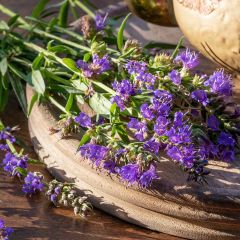
Hyssopus officinalis
- Flowering time August to October
- Height at maturity 60 cm
Discover other Hyssopus
View all →Available in 2 sizes
Available in 0 sizes
Available in 1 sizes
Available in 1 sizes
Planting and sowing
Where to Plant and Sow Hyssop?
Despite its Mediterranean origins, Hyssop tolerates cold well down to -15°C in well-drained soil and grows throughout France. In harsher regions, it is wise to cultivate it in a pot on the terrace or balcony, which you should protect from frost in winter.
Easy to grow, it thrives in full sun, although it tolerates partial shade in ordinary, dry, poor, or even rocky soil. It adapts to most soils as long as they are well-drained. It prefers full sun and warm exposures. However, it dislikes excess moisture, such as winter flooding, which can be fatal: in clayey or overly moist soil, do not give up but plant it on a mound.
Ensure sufficient spacing between plants.
Highly melliferous, Hyssop is a useful plant for enhancing pollination in the orchard as well as in the vegetable garden, where its nectar-rich flowers will irresistibly attract pollinating insects. Common hyssop is also a natural repellent for ants, slugs, and snails.
It has its place in a herb garden. With its bushy habit, lovely flowering spikes, and fine decorative foliage, it also integrates easily into natural or wild gardens as a rockery plant, in borders, or in mass plantings. In rocky gardens and areas without irrigation, it is ideal for forming flowering clumps all summer long in small rockeries or dry slopes.
In small spaces or on a balcony, it is also well-suited for pot cultivation.
When to Sow, When to Plant?
The planting of hyssop is preferably done in autumn, in September-October, or possibly in spring from March to May, after the frosts. Sow hyssop seeds from March-April to May.
How to Plant?
In the Ground
In heavy and poorly drained soil: incorporate coarse sand or a mix of gravel into the garden soil to improve drainage. Space plants 40 to 60 cm apart and plan for 4 to 5 plants per m².
- Dig a hole 2 to 3 times wider than the root ball
- Loosen the extracted soil well
- Spread a draining layer at the bottom of the planting hole
- Place the root ball in the middle of the hole
- Fill in with compost
- Lightly compact
- Water at planting, then moderately without flooding the roots
In a Pot
You can also grow hyssop in a pot (choose a container that is at least 50 cm in diameter). The substrate must be light and very well-draining to prevent water from stagnating at the roots.
- In a large pot, spread a good layer of gravel, stones, or clay balls
- Plant in a potting mix for Mediterranean plants and coarse river sand or pumice
- Water at planting, then without excess
- In cold regions, store the pot for winter and bring it out as soon as temperatures warm up
How to Sow Hyssop?
Sowing Under Frame:
Sow hyssop seeds in March under a frame in trays or pots using a light seed compost. Barely cover the seeds. Keep warm at 15-20°C until germination. Transplant the seedlings into pots when they are sturdy enough to handle. Once all risk of frost has passed and the seedlings reach about 20 cm in height, you can plant them outside in the sun in well-drained soil.
Sowing Directly:
- From April to May, sow in rows spaced 30 cm apart or broadcast on fine soil
- Cover the seeds with 1 or 2 cm of compost, then firm down with the back of a rake
- Water gently and keep moist until germination, which usually takes 14 to 21 days
- Thin out to keep only one plant every 40 to 60 cm
All our tips for successfully sowing aromatic plants are on our blog!
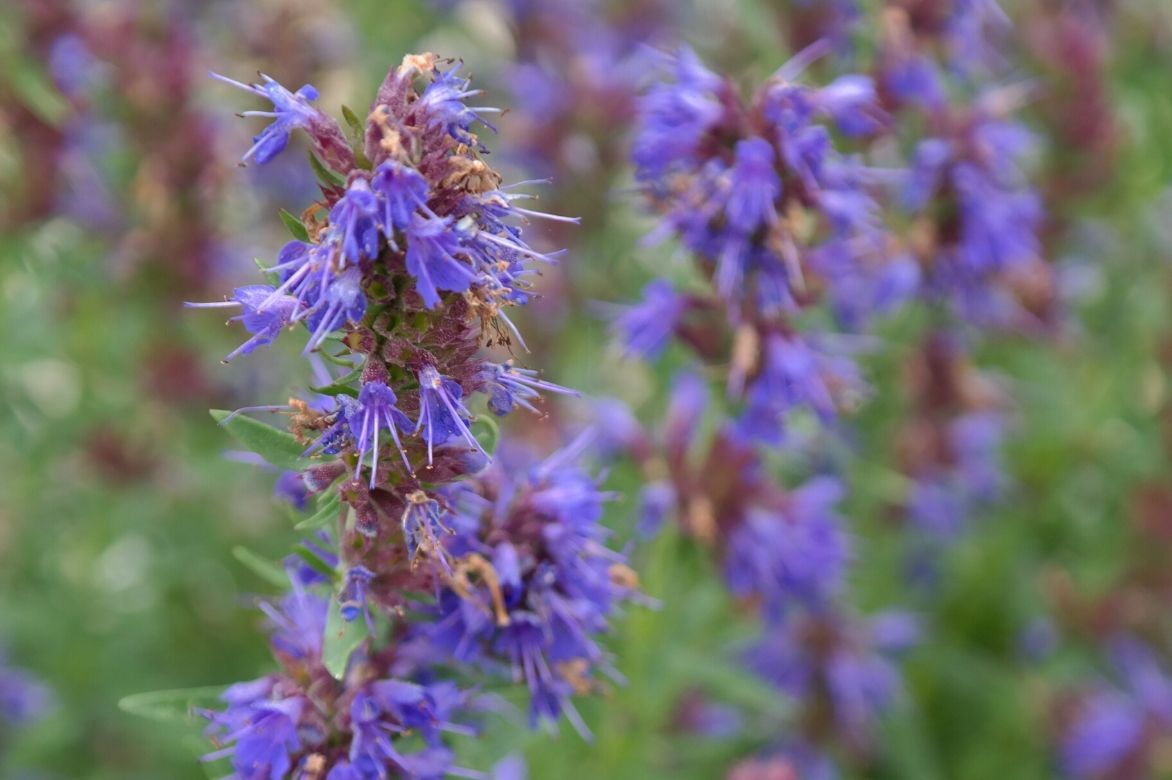
Read also
Sowing of aromatic plantsHarvesting, Preserving, and Using Hyssop
When and how to harvest?
Flowering tops are picked at the beginning of flowering. Fresh leaves are harvested as needed.
Storage:
Fresh leaf stems can be kept for a few days wrapped in absorbent paper and placed in the refrigerator or submerged in a glass of water. Leaves of Hyssop can be dried, but they will lose their aroma: cut the stems before flowering and dry them in the shade and in the open air. Store them in paper bags or airtight boxes.
Uses and benefits:
Finely chopped fresh leaves and Hyssop flowers are used to flavour salads, vegetables, soups, as well as stuffings for pork, goose, or duck. Dried Hyssop flowers are used as a seasoning to flavour oils and dressings. It also flavours certain liqueurs such as Vermouth and pastis, and is one of the main ingredients in the elixir of Grande-Chartreuse and Bénédictine.
It is a plant widely used in phytotherapy. All parts of the plant have therapeutic properties: antiseptic, stimulating, digestive, anti-rheumatic, and expectorant to relieve coughs. Common Hyssop is also used in infusions (20 g of leaves per litre of boiling water) to combat respiratory infections (lung and bronchial conditions), ENT disorders, aid digestion, and soothe the nervous system. In the vegetable garden, this infusion is sprayed to combat certain bacterial diseases.
Caution: Hyssop essential oil is toxic and must be used with extreme care, exclusively for external use, and only under medical advice.
→ Also discover Servane’s tutorial: How to dry and use Hyssop?
Maintenance and Care
This perennial undershrub requires little attention.
Water sparingly during growth and only in cases of prolonged drought, if the soil is really very dry.
Weed regularly around the young plants. Mulch to reduce the need for watering.
While not essential, annual pruning encourages vigorous regrowth and more abundant flowering. At the end of flowering or in March, use pruning shears to cut back the faded stems to 3 cm above the old wood. Regular pruning and the removal of flowering stems will promote new, tender shoots.
Every four years, rejuvenate old clumps of hyssop by dividing them.
In the northern regions of the Loire, bring potted Hyssops indoors before the first frosts, keeping them sheltered from the cold in an unheated room and maintain the substrate almost dry.
Robust, hyssop is rarely diseased, but it can be susceptible to rust, a fairly common fungal disease. Common hyssop is a repellent for ants, slugs, and snails: make infusions to spray against these pests.
Multiplication
Two easy ways to propagate Hyssop: at the end of spring or the beginning of summer by cuttings, or by dividing the stumps in spring or autumn.
Propagation by Cuttings
- Take 10 cm long shoots
- Remove the leaves from the base
- Insert the cuttings into good draining compost
- Place in the shade and keep just moist until they take root
- Transplant them into the ground or pots when the seedlings reach 20 cm
Division
- Divide the oldest stumps
- Use a fork to lift the clumps
- With the edge of a spade, divide pieces with shoots and roots
- Replant them without delay
- Water regularly to aid establishment
Associate with the garden
endowed with repellent and melliferous properties, Hyssop is a good ally in the vegetable garden. It repels slugs, snails, and ants while attracting pollinators that enhance the fertilisation of your vegetable plants. It will also easily fit into a vicar’s garden, in a patch of herbs reminiscent of the garrigue, alongside other melliferous perennial plants that thrive in the sun, such as Thyme, Rosemary, Roman Chamomile, Marjoram, or its cousin Agastache.
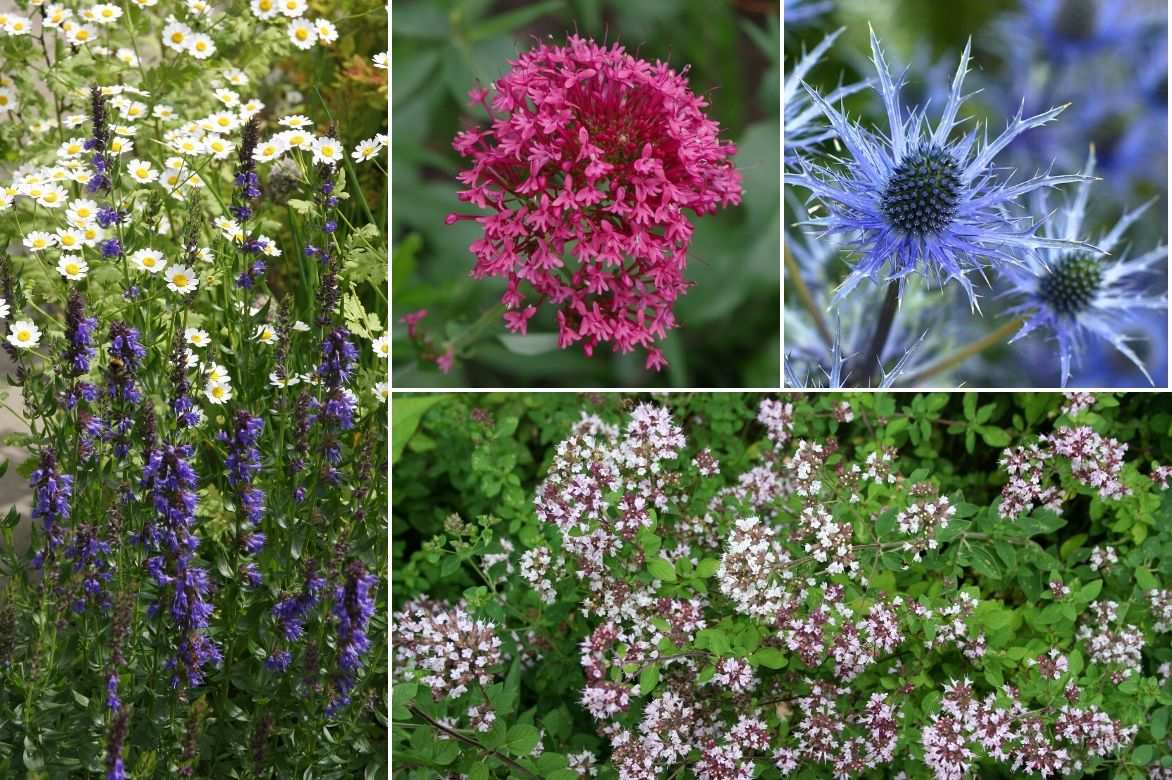
An example of a natural mass association in dry soil: Hyssop and golden chamomile (or not), garden valerian, sea holly, and oregano
A Mediterranean plant by nature, it finds its place in a dry garden alongside plants as undemanding as it is. You can install it within a rockery or at the edge of a Mediterranean bed and pair it with drought-resistant perennials and Mediterranean aromatic perennials such as lavenders, santolines, a few clumps of nepetas, Helichrysum italicum, Sages, Cistus, wormwoods, and sedums.
→ Discover more association ideas with hyssop in our advice sheet!
Useful resources
- Discover our tips for growing hyssop in a pot
- Get inspired by our ideas for combinations with our Mediterranean perennials and plants for a dry garden
- What to plant in stony soil?
- Discover Elizabeth’s Mediterranean garden!
- Subscribe!
- Contents
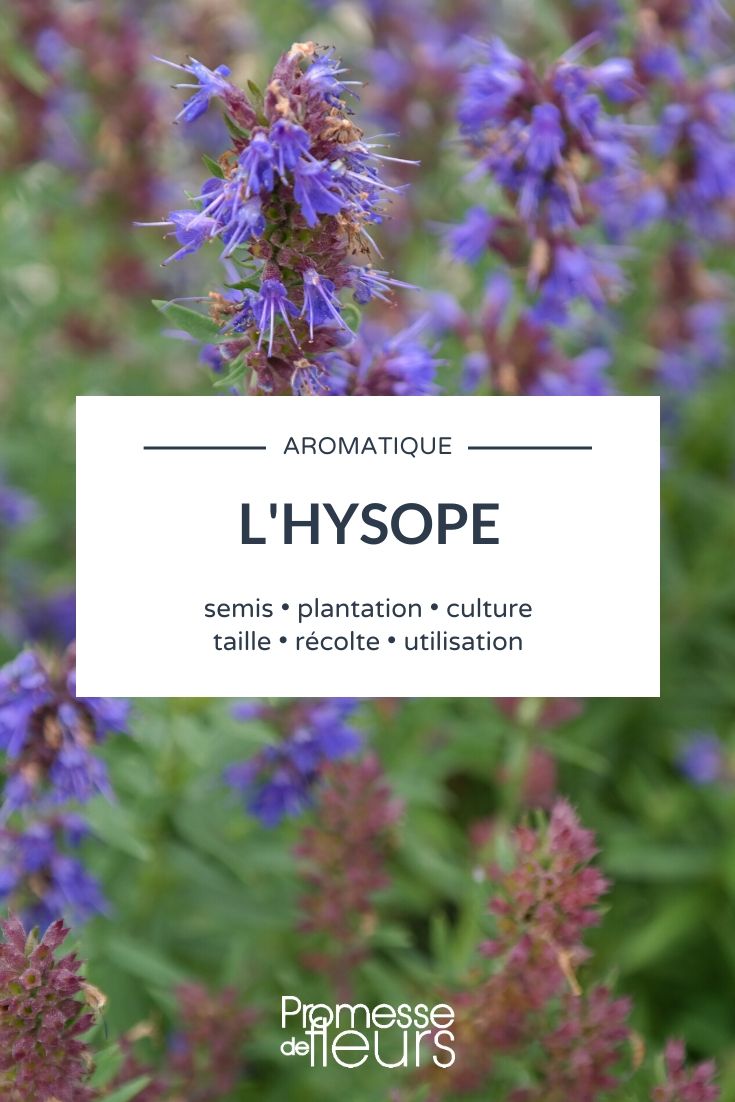
































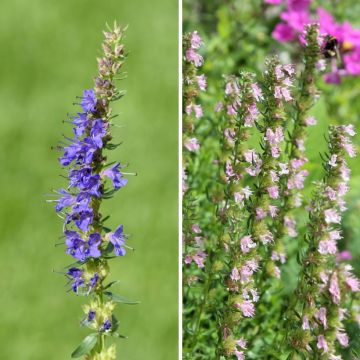
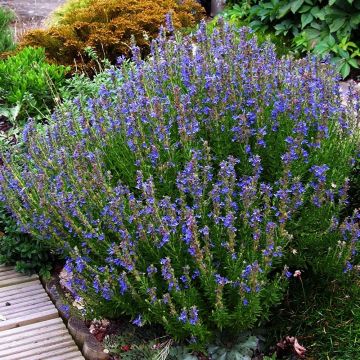
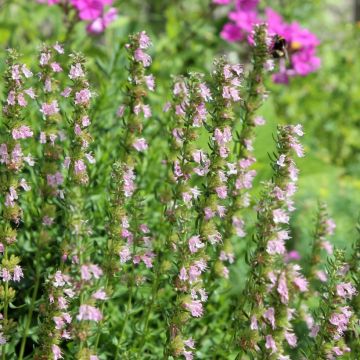
Comments